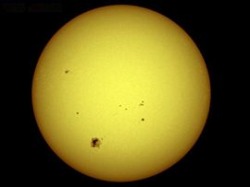The Sun

The Sun is the star at the center of the Solar System. The Earth and other matter (including other planets, asteroids, meteoroids, comets, and dust) orbit the Sun,[9] which by itself accounts for about 99.8% of the Solar System'smass. Energy from the Sun, in the form of sunlight and heat, supports almost all life on Earth via photosynthesis, and drives the Earth's climate and weather.
The surface of the Sun consists of hydrogen (about 74% of its mass, or 92% of its volume), helium (about 24-25% of mass,[10] 7% of volume), and trace quantities of other elements, including iron, nickel, oxygen, silicon, sulfur, magnesium, carbon, neon, calcium, and chromium.[11] The Sun has a spectral class of G2V. G2 means that it has a surface temperature of approximately 5,780 K, giving it a white color that often, because of atmospheric scattering, appears yellow when seen from the surface of the Earth. This is a subtractive effect, as the preferential scattering of blue light (causing the sky color) removes enough blue light to leave a residual reddishness that is perceived as yellow. (When low enough in the sky, the Sun appears orange or red, due to this scattering.)
Its spectrum contains lines of ionized and neutral metals as well as very weak hydrogen lines. The V (Roman five) in the spectral class indicates that the Sun, like most stars, is a main sequence star. This means that it generates its energy by nuclear fusion of hydrogen nuclei into helium. There are more than 100 million G2 class stars in our galaxy. Once regarded as a small and relatively insignificant star, the Sun is now known to be brighter than 85% of the stars in the galaxy, most of which are red dwarfs.[12]
The Sun orbits the center of the Milky Waygalaxy at a distance of approximately 26,000 light-years from the galactic center, completing one revolution in about 225–250 million years. Its approximate orbital speed is 220 kilometers per second, plus or minus 20 km/s. This is equivalent to about one light-year every 1,400 years, and about one AU every 8 days. These measurements of galactic distance and speed are as accurate as we can get given our current knowledge, but will change as we learn more.[13]
The Sun is currently traveling through the Local Interstellar Cloud in the low-density Local Bubble zone of diffuse high-temperature gas, in the inner rim of the Orion Arm of the Milky Way Galaxy, between the larger Perseus and Sagittarius arms of the galaxy. Of the 50 nearest stellar systems within 17 light years from the Earth, the Sun ranks 4th in absolute magnitude as a fourth magnitude star (M=4.83).
